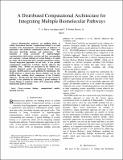| dc.contributor.author | Ayyadurai, Shiva | |
| dc.contributor.author | Dewey, C. Forbes | |
| dc.date.accessioned | 2007-01-23T19:28:53Z | |
| dc.date.available | 2007-01-23T19:28:53Z | |
| dc.date.issued | 2007-01 | |
| dc.identifier.uri | http://hdl.handle.net/1721.1/35780 | |
| dc.description.abstract | Biomolecular pathways are building blocks of cellular biochemical function. Computational biology is in rapid transition from diagrammatic representation of pathways to quantitative and predictive mathematical models, which span time-scales, knowledge domains and spatial-scales. This transition is being accelerated by high-throughput experimentation which isolates reactions and their corresponding rate constants. A grand challenge of systems biology is to model the whole cell by integrating these emerging quantitative biomolecular pathway models. Current integration approaches do not scale. A new parallel and distributed computational architecture, CytoSolve, directly addresses this scalability issue. Results are presented in the solution of a concrete biological model: the Epidermal Growth Factor Receptor (EGFR) pathway model published by Kholodenko. The EGFR pathway is selected since known solutions exist for this problem, enabling direct confirmation of the CytoSolve approach. Results from this effort demonstrate that CytoSolve provides a core platform for addressing a grand challenge of systems biology to model the whole cell by integrating multiple biomolecular pathway models. | en |
| dc.description.sponsorship | Singapore-MIT Alliance (SMA) | en |
| dc.format.extent | 143075 bytes | |
| dc.format.mimetype | application/pdf | |
| dc.language.iso | en | en |
| dc.relation.ispartofseries | Computation and Systems Biology (CSB) | en |
| dc.subject | Systems Biology | en |
| dc.subject | Computational Models | en |
| dc.subject | Signaling Networks | en |
| dc.title | A Distributed Computational Architecture for Integrating Multiple Biomolecular Pathways | en |
| dc.type | Article | en |
